
A bump-out addition is right for you if you want to add extra space to your home without adding a new room. Learn about the different bump-out addition costs.
The right sink can turn your space into a culinary oasis


Choosing between the many types of kitchen sinks can seem daunting, but you can narrow it down depending on the size and needs of your kitchen.
Most sink types are differentiated by the number of bowls, sink sizes, and installation method. For example, single-basin sinks are ideal for soaking large cookware, while double-basin sinks work great for everyday dish washing in spaces that don’t have a full-sized dishwasher. If you need help determining which sink type to purchase, consider hiring a local kitchen remodeler to make suggestions and schedule installation.
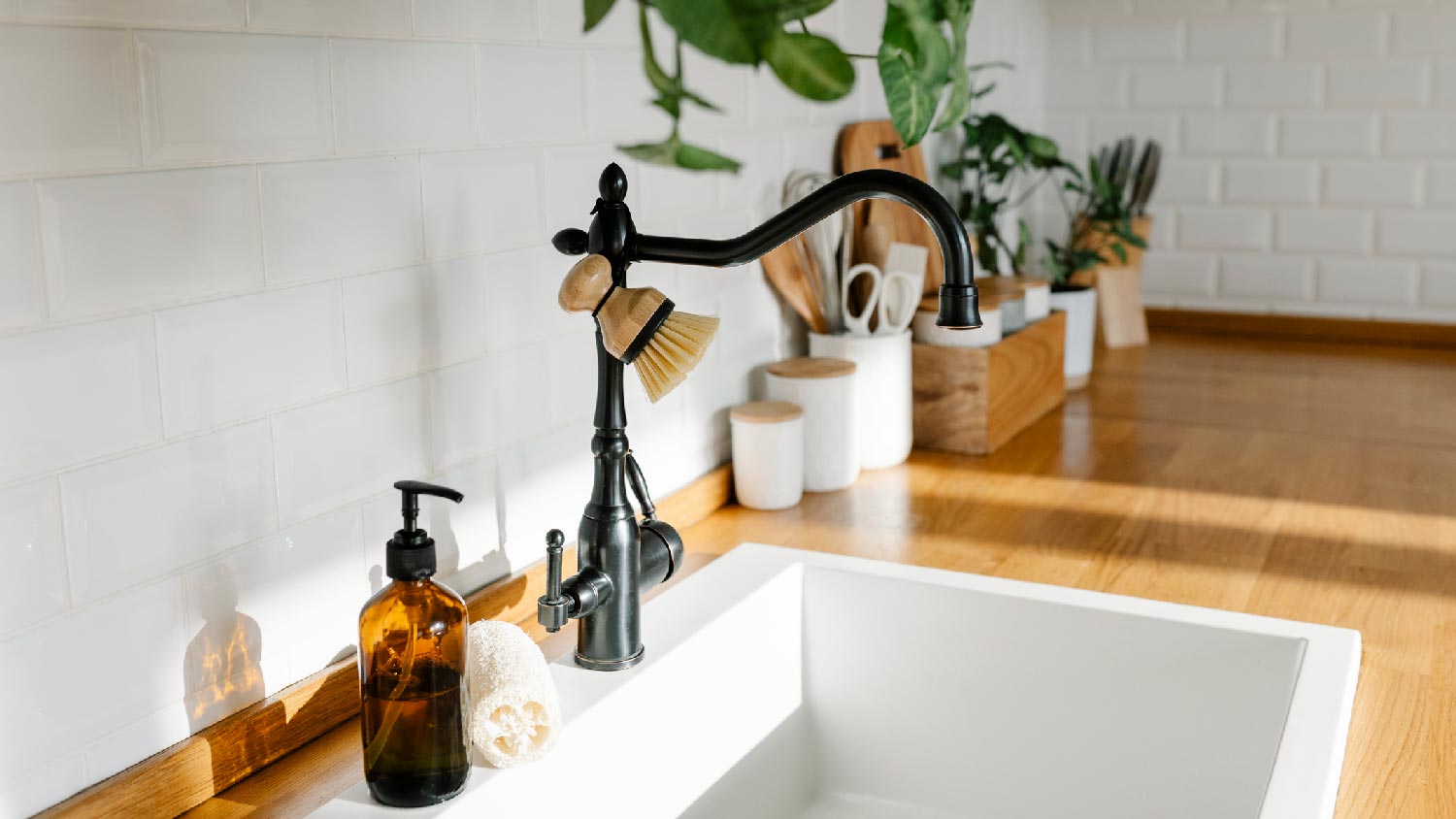
Single-basin sinks can be as long as 33 inches and are perfect for washing or soaking large pots and pans since they don’t have a divider in the center. If you have a large household or do high-volume cooking, a single-basin sink can make prep work and cleanup much easier. The only downside is that these sinks don’t have space to dry your dishes, so you may need a separate drying mat or rack.
| Pros | Cons |
|---|---|
| Spacious for large items | Limited separation for multitasking |
| Takes up less space for smaller kitchens | No space to dry dishes |
| Easier to clean | Limited options for sink accessories |
Best for: Small kitchens or those who have a large household.

Unlike a single-basin sink, the double-basin sink has two bowls that are separated by a divider. The bowls can also be different sizes, with the area for drying or soaking dishes smaller than the bowl for rinsing or scrubbing. These sinks can reach up to 48 inches in size, so it’s ideal for larger kitchens with more countertop space. A double basin sink often makes more sense for a house without a dishwasher, since you can rinse off your dishes in one bowl and let them dry in the other. While the divider can get in the way in some cases, low divider double basin sinks allow for easier moving between the two basins while still providing separate washing and drying areas.
| Pros | Cons |
|---|---|
| Separates tasks | Less space for large items |
| Keeps dirty and clean dishes separate | Takes up more counter space |
| Can accommodate dual faucet setup | Cleaning divider can get in the way |
Best for: Larger kitchens or homes without a dishwasher.

Drop-in sinks, also known as top-mount sinks, drop directly into the opening of the countertop and are secured in place underneath with screws and clips. These sinks usually have a lip that sits around the edge of the sink, plus it’s the only type that works with laminate countertops. Top-mount sink installation requires that the sink has the exact number of holes needed for the faucet, so preparation is key.
| Pros | Cons |
|---|---|
| Easy to install | Sink lip takes up counter space |
| More affordable | Harder to clean around the edges |
| Compatible with laminate countertops | Has a less modern appearance |
Best for: DIYers or kitchens with laminate countertops.
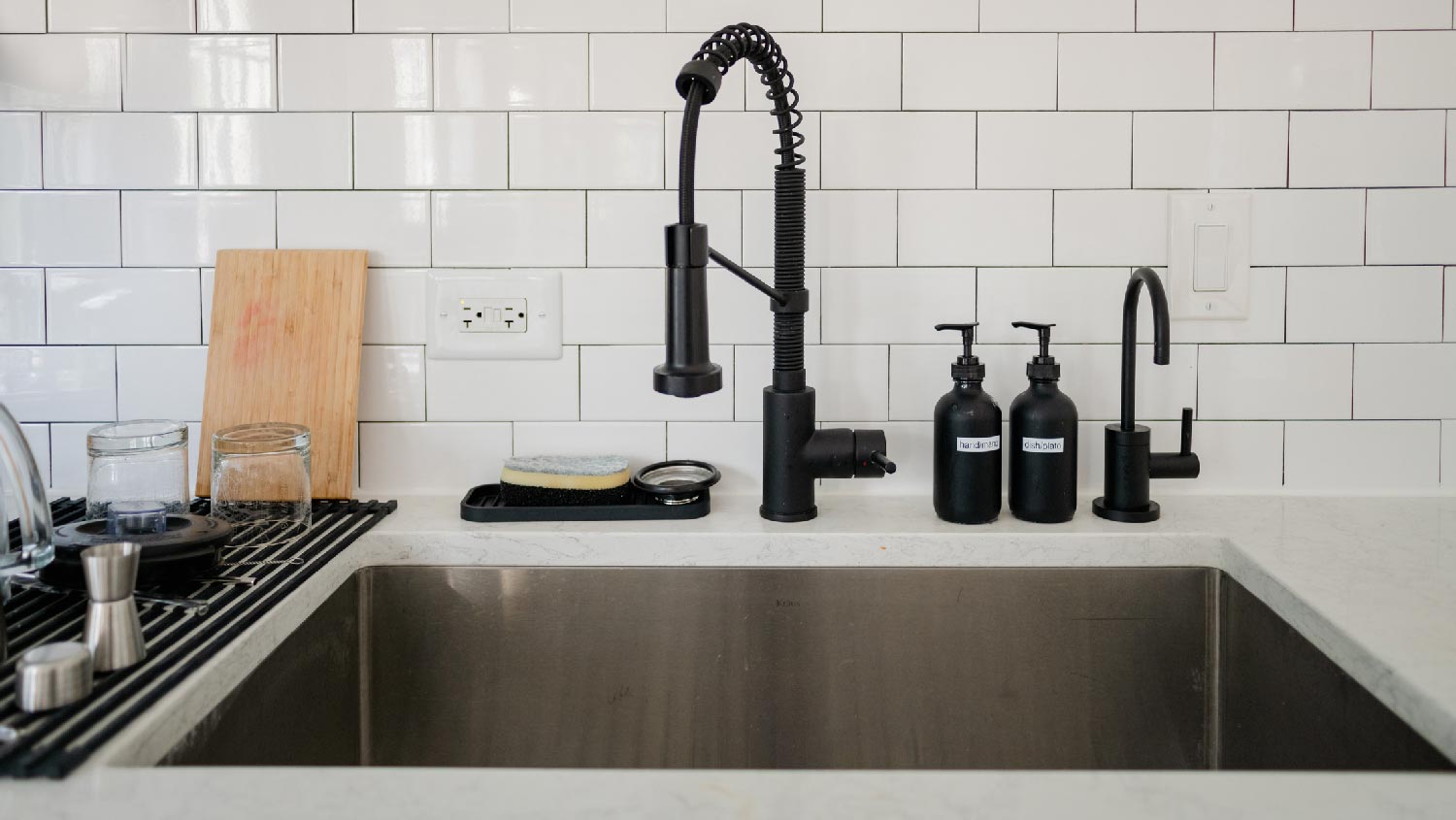
For kitchens that need to maximize space, the undermount sink is an excellent option. Because there is no lip above the counter, homeowners can sweep crumbs or countertop spills directly into the sink without a barrier. Although undermount sinks are more expensive than drop-in sinks, they are higher quality than other models. Plus, this sink type is heavy since it’s mounted from underneath the counter surface, which is not compatible with laminate or tile countertops.
| Pros | Cons |
|---|---|
| Maximizes counter space | Higher cost |
| Modern and seamless look | Not compatible with all counter materials |
| Easier to clean countertop | Harder to install |
Best for: Those who want to maximize countertop space.

Also called an apron sink, farmhouse sinks have a deep basin with an exposed front, so the cabinets underneath the sink will need to be shorter than the standard size to accommodate them. These types of sinks are single basin with no divider, and they can be freestanding or integrated into the cabinetry. Homes with a more traditional or rustic style look great with a farmhouse sink, and it’s an ideal sink choice to wash larger cookware.
| Pros | Cons |
|---|---|
| Large and deep | Requires smaller cabinets underneath |
| Stylish, rustic appearance | Deep basin requires more bending |
| Accommodates oversized cookware | May require a custom countertop |
Best for: Kitchens with large cookware or homes with a rustic style
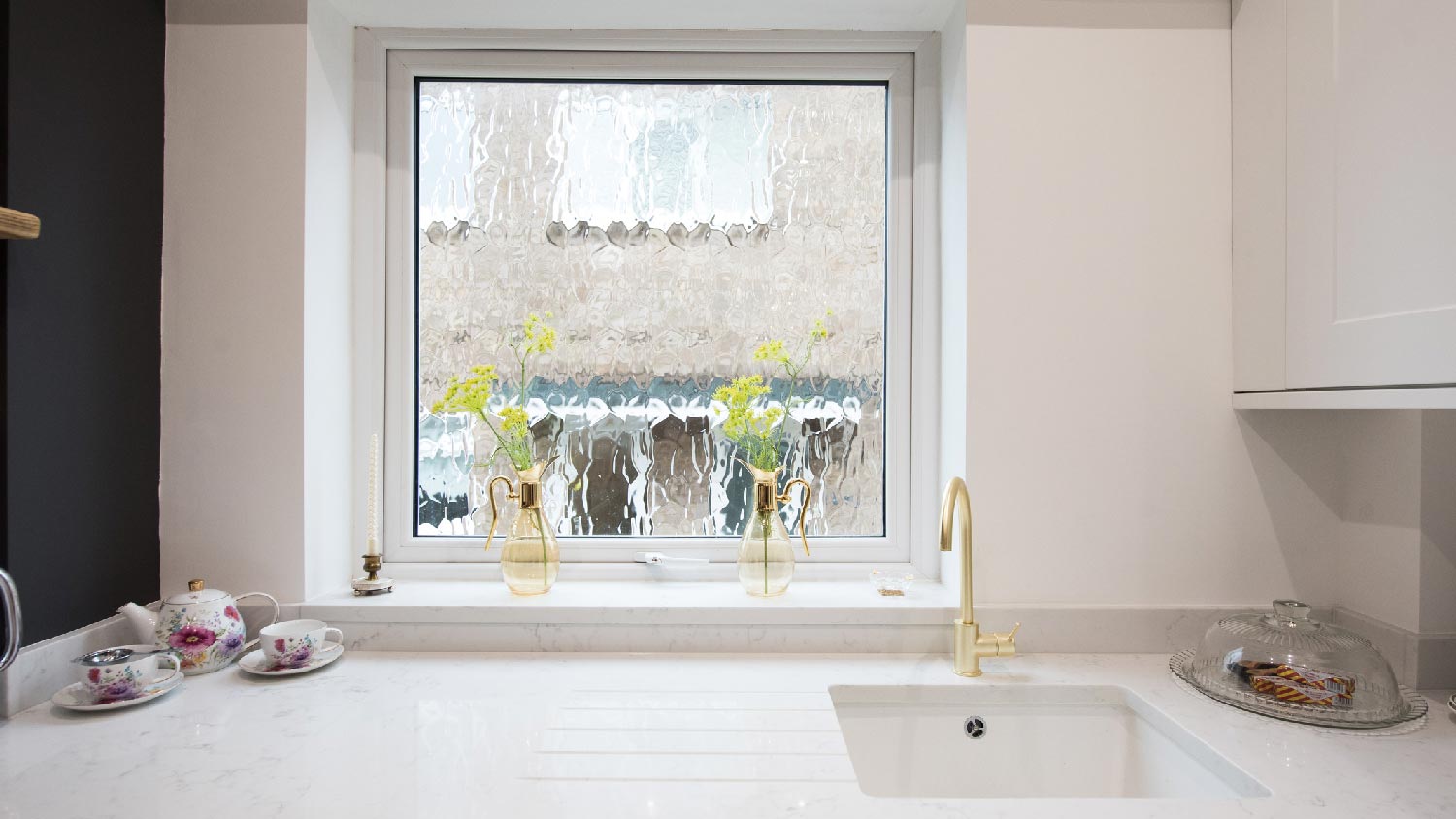
Small kitchen spaces can benefit from a drainboard sink, which features a small basin and an adjacent counter-level drainboard. Often found in galley or apartment kitchens, drainboard sinks can trap water quickly and return it to the sink to its drain. People who host or entertain frequently may not have much use for a drainboard sink, but it works well for those who don’t have a large family or roommates.
| Pros | Cons |
|---|---|
| Efficient water drainage | Takes up more counter space |
| Reduces clutter on countertops | Requires maintenance of drainboard |
| Ideal for smaller kitchens | May limit space for large items |
Best for: Smaller kitchens or those with fewer people in their household
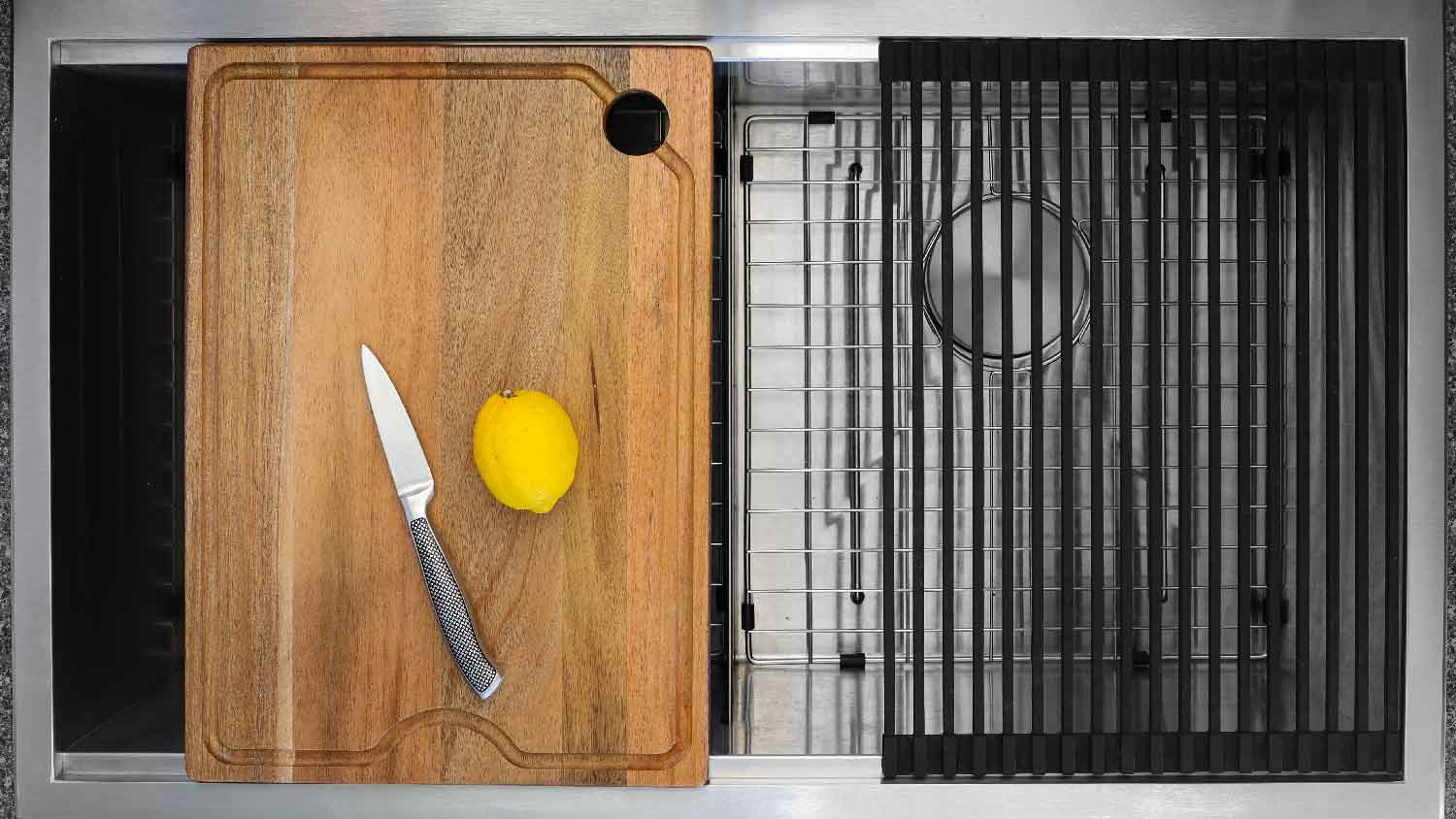
If you want to level up your kitchen game, look no further than the workstation sink, an innovative upgrade for home chefs and culinary enthusiasts. A workstation sink is designed with built-in accessories like cutting boards, colanders, and drying racks, turning the sink area into a multifunctional workspace. They’re ideal for homeowners who love to cook and entertain, offering versatility and efficiency, though the enhanced design comes with a higher price tag and requires skilled installation.
| Pros | Cons |
|---|---|
| Integrated accessories | More expensive than standard sinks |
| Versatile for food prep | May require custom cabinets |
| Maximizes counter space | Harder to install |
Best for: Avid cooks

Integrated sinks are built with the countertops so that the two kitchen features become one. They’re often made from the best kitchen sink materials, such as quartz, stainless steel, natural stone, and acrylic. The downside to an integrated sink is that it’s harder to replace without replacing your countertops. However, if you’re going for a seamless, customized look, an integrated sink will fit your needs.
| Pros | Cons |
|---|---|
| Seamless design | Higher cost |
| Easy to clean | Harder to install |
| Minimizes dirt and grime buildup | Limited variety of materials |
Best for: Kitchens with a seamless, modern look.
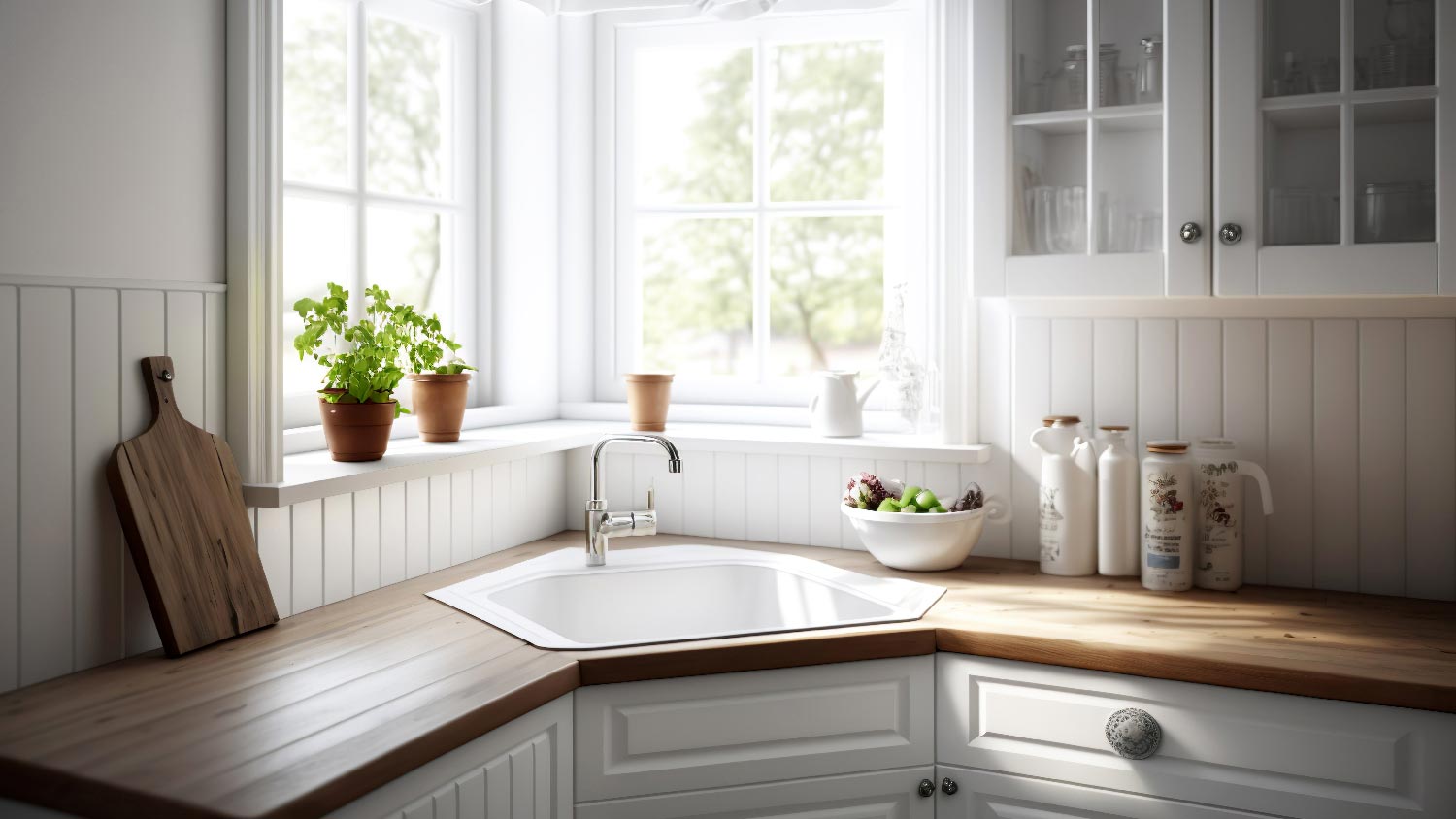
This sink type gets its name from its basin configuration, with two basins set at right angles to each other. It’s typically found in smaller kitchens, but they are rare for their slightly impractical shape. Most corner sinks are separated by the faucet, but larger models may include a built-in drying section in between the basins.
| Pros | Cons |
|---|---|
| Utilizes corner space efficiently | Harder to install |
| Maximizes counter space | Limited accessibility |
| Ideal for smaller kitchens | Limited size and style options |
Best for: Smaller kitchens
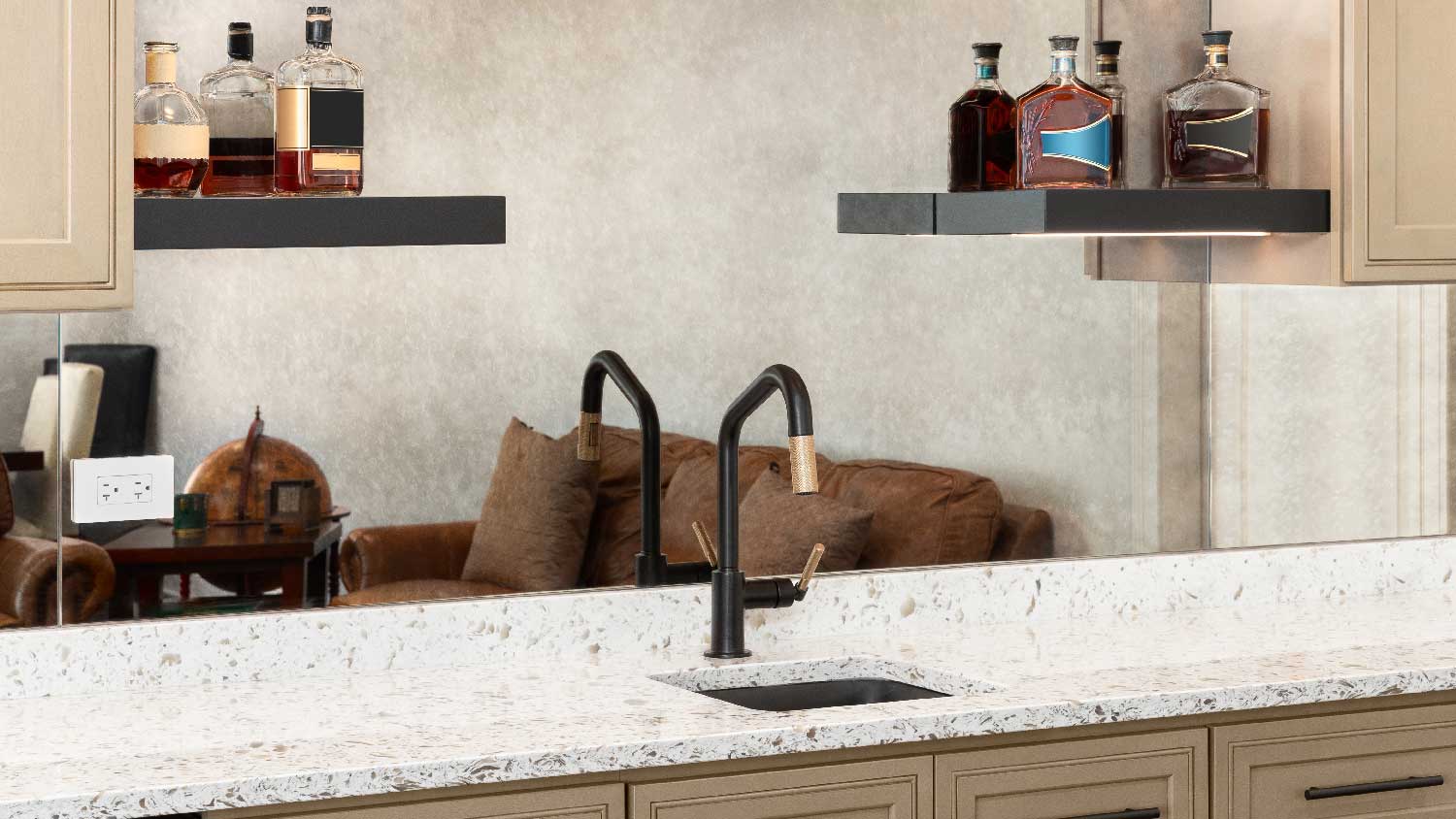
A bar sink is a smaller, secondary sink, ideal for entertainment areas like wet bars, home theaters, or outdoor kitchens. It’s designed to handle drink prep, glass rinsing, and light cleanup tasks. While they add convenience to entertainment areas, they’re not suitable for replacing a primary kitchen sink—they’re compact and therefore less equipped for heavy-duty tasks like cleaning large pots and pans. This sink type can come in a variety of styles, including undermount, drop-in, or integrated into a countertop.
| Pros | Cons |
|---|---|
| Adds convenience to entertainment areas | Limited capacity for large items |
| Saves space in kitchen cleanup | Additional plumbing and installation required |
| Ideal for small kitchens or wet bars | Not suitable for heavy-duty tasks |
Best for: Homeowners who frequently host gatherings or have separate entertainment areas
The best kitchen sink is the one that makes the most sense for your space and your lifestyle. The considerations below can help determine which type of kitchen sink will be the best fit for your home.
The larger the sink, the more likely you’re going to spend on it. If your kitchen sink budget is on the lower end, a drop-in, stainless steel sink is more affordable than an integrated quartz sink. The less you have to customize your cabinets or countertops to fit your sink, the lower the cost.
Keep in mind that the cost to install or replace a sink ranges from $220 to $650, depending on the size, type, size, and material.
The size of your kitchen and the amount of countertop space can help narrow down what type of sink it can accommodate. For example, if your kitchen is on the smaller side, a large double-basin sink may overwhelm the space and be the wrong scale for the room. Larger kitchens, on the other hand, are better suited for big sinks and leave plenty of square footage for countertops.
If your sink will get a ton of use and needs to withstand more frequent scrub downs, stainless steel is a great material to consider. Other options, such as porcelain, cast iron, or copper kitchen sinks, may be harder to clean and take a bit more elbow grease to get in tip-top shape. But if your sink will see minimal use and you’re more concerned about its aesthetic, a more precious material may be a better fit.
Replacing a kitchen sink can be a DIY project for those with some plumbing and handyperson skills, but it’s important to consider the type of sink you’re installing, how large the replacement sink is, and the extent of plumbing involved.
If you’re replacing an existing sink with a similar size and style, the installation process can be relatively straightforward. Upgrading to a larger sink or changing the configuration, such as switching from a drop-in to an undermount sink, involves more complex installation.
Some situations where a sink replacement may require professional help include:
Upgrading to a larger sink that requires cutting countertops or modifying cabinetry.
Switching to an undermount sink.
Adding features like a water filtration system that require plumbing expertise.
Reconfiguring the plumbing layout to accommodate a new location.
Installing a sink in a tougher countertop material, such as a stone or quartz sink
If you’re unsure or uncomfortable with any aspect of the installation, it’s best to get a local sink installation professional to ensure the job is done correctly and to avoid potential problems down the line.
Melissa Graham contributed to this report.
From average costs to expert advice, get all the answers you need to get your job done.

A bump-out addition is right for you if you want to add extra space to your home without adding a new room. Learn about the different bump-out addition costs.

Remodeling your bathroom can add significant value to your home. Your bathroom remodel cost in Columbus, OH will depend on size, fixtures, materials, labor, and other factors.

Whether you’re looking to hire a pro or DIY, the cost of a kitchen design can add up quickly. Learn the cost factors involved in designing your kitchen.

An updated bathtub can give a bathroom a whole new look. Find out how much it costs to replace a bathtub in Tampa, FL, including prices by type and labor costs.

Understanding the types of kitchen remodel work that require a permit and how to apply for one will help you avoid any complications or fines further down the line. Read this guide to understand all the important steps.

Quartz sinks can be an affordable and simple-to-maintain alternative to stone sinks. Learn about quartz sinks pros and cons in this guide.